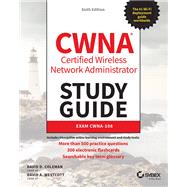The #1 selling Wi-Fi networking reference guide in the world
The CWNA: Certified Wireless Network Administrator Study Guide is the ultimate preparation resource for the CWNA exam. Fully updated to align with the latest version of the exam, this book features expert coverage of all exam objectives to help you pass the exam. But passing the exam is just a first step. For over 16 years, the CWNA Study Guide has helped individuals jump-start their wireless networking careers. Wireless networking professionals across the globe use this book as their workplace reference guide for enterprise Wi-Fi technology.
Owning this book provides you with a foundation of knowledge for important Wi-Fi networking topics, including:
- Radio frequency (RF) fundamentals
- 802.11 MAC and medium access
- Wireless LAN topologies and architecture
- WLAN design, troubleshooting and validation
- Wi-Fi networking security
The book authors have over 40 years of combined Wi-Fi networking expertise and provide real-world insights that you can leverage in your wireless networking career. Each of the book’s 20 chapters breaks down complex topics into easy to understand nuggets of useful information. Each chapter has review questions that help you gauge your progress along the way. Additionally, hands-on exercises allow you to practice applying CWNA concepts to real-world scenarios. You also get a year of free access to the Sybex online interactive learning environment, which features additional resources and study aids, including bonus practice exam questions.
The CWNA certification is a de facto standard for anyone working with wireless technology. It shows employers that you have demonstrated competence in critical areas, and have the knowledge and skills to perform essential duties that keep their wireless networks functioning and safe. The CWNA: Certified Wireless Network Administrator Study Guide gives you everything you need to pass the exam with flying colors.








